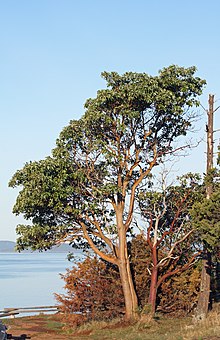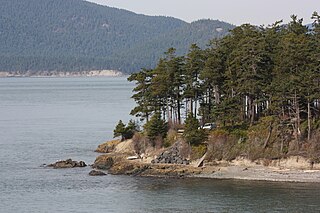
The Douglas fir is an evergreen conifer species in the pine family, Pinaceae. It is native to western North America and is also known as Douglas-fir, Douglas spruce, Oregon pine, and Columbian pine. There are three varieties: coast Douglas-fir, Rocky Mountain Douglas-fir and Mexican Douglas-fir.

Quercus kelloggii, the California black oak or Kellogg oak, is an oak in the red oak section native to western North America. Although genetically separated from them for more than 20 million years, its leaves are remarkably similar in appearance to several other members of the red oak section including the red oak and the black oak found in eastern and central North America.

Quercus garryana is an oak tree species of the Pacific Northwest, with a range stretching from southern California to southwestern British Columbia. It is commonly known as the Garry Oak, Oregon white oak or Oregon oak. It grows from sea level to an altitude of 690 feet in the northern part of its range, and from 980 to 5,900 ft in the south of the range in California. The eponymous Nicholas Garry was deputy governor of the Hudson's Bay Company.

Umbellularia californica is a large hardwood tree native to coastal forests and the Sierra foothills of California, and to coastal forests extending into Oregon. It is endemic to the California Floristic Province. It is the sole species in the genus Umbellularia.
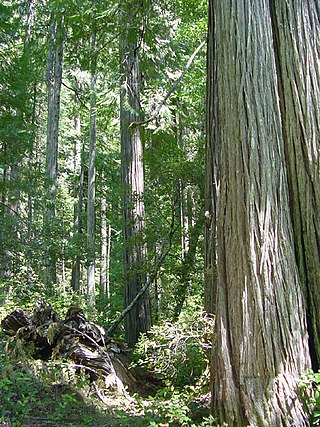
Chamaecyparis lawsoniana, known as Port Orford cedar or Lawson cypress, is a species of conifer in the genus Chamaecyparis, family Cupressaceae. It is native to Oregon and northwestern California, and grows from sea level up to 4,900 feet (1,500 m) in the valleys of the Klamath Mountains, often along streams.

Alnus rubra, the red alder, is a deciduous broadleaf tree native to western North America.

Arbutus is a genus of 12 accepted species of flowering plants in the family Ericaceae, native to temperate regions of the Mediterranean, western Europe, the Canary Islands and North America, and commonly called madrones or strawberry trees. The name Arbutus was taken by taxonomists from Latin, where it referred to the species now designated Arbutus unedo.

Phytophthora ramorum is the oomycete known to cause the disease Sudden Oak Death (SOD). The disease kills oak and other species of trees and has had devastating effects on the oak populations in California and Oregon, as well as being present in Europe. Symptoms include bleeding cankers on the tree's trunk and dieback of the foliage, in many cases leading to the death of the tree.
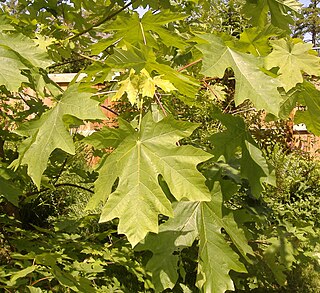
Acer macrophyllum, the bigleaf maple or Oregon maple, is a large deciduous tree in the genus Acer. It is native to western North America. In addition to uses by animals, it is of some culinary and woodworking interest.

Tsuga heterophylla, the western hemlock or western hemlock-spruce, is a species of hemlock native to the west coast of North America, with its northwestern limit on the Kenai Peninsula, Alaska, and its southeastern limit in northern Sonoma County, California. The Latin species name means 'variable leaves'.

Fraxinus latifolia, the Oregon ash, is a member of the ash genus Fraxinus, native to western North America.

California mixed evergreen forest is a plant community found in the mountain ranges of California and southwestern Oregon.

California oak woodland is a plant community found throughout the California chaparral and woodlands ecoregion of California in the United States and northwestern Baja California in Mexico. Oak woodland is widespread at lower elevations in coastal California; in interior valleys of the Coast Ranges, Transverse Ranges and Peninsular Ranges; and in a ring around the California Central Valley grasslands. The dominant trees are oaks, interspersed with other broadleaf and coniferous trees, with an understory of grasses, herbs, geophytes, and California native plants.
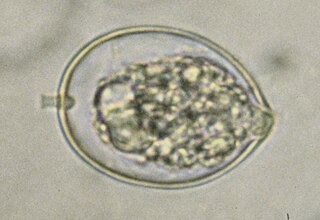
Phytophthora cactorum is a fungal-like plant pathogen belonging to the Oomycota phylum. It is the causal agent of root rot on rhododendron and many other species, as well as leather rot of strawberries.

Arbutus xalapensis, commonly known as the Texas madrone, Amazaquitl, or Texas madroño, is a species of flowering plant in the heather family. It is native to Central America, the southwestern United States, and throughout Mexico. It is found in canyons and mountains, on rocky plains, and in oak woodlands, at altitudes of up to 3,000 m in the south of the range, but lower, down to 600 m in the north of the range.
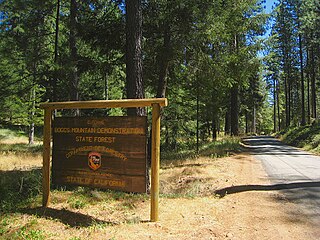
Boggs Mountain Demonstration State Forest is a state forest in Lake County, California that covers the northwest of Boggs Mountain. It was founded in 1949, and came into operation in 1950 when most of the site had been clear cut. The purpose was to demonstrate good practices in restoring and managing a forest. The state forest was open for recreational use, including camping, hiking, mountain biking etc. The 2015 Valley Fire destroyed 80% of the trees. The state forest as of 2021 was replanting saplings.
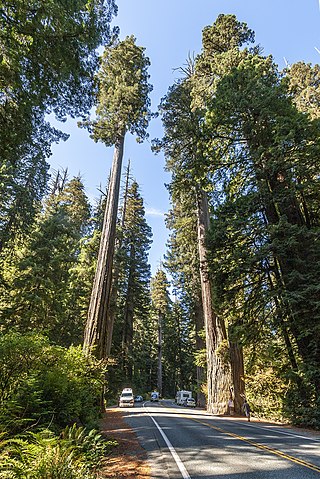
Sequoia sempervirens is the sole living species of the genus Sequoia in the cypress family Cupressaceae. Common names include coast redwood, coastal redwood and California redwood. It is an evergreen, long-lived, monoecious tree living 1,200–2,200 years or more. This species includes the tallest living trees on Earth, reaching up to 115.9 m (380.1 ft) in height and up to 8.9 m (29 ft) in diameter at breast height. These trees are also among the longest-living organisms on Earth. Before commercial logging and clearing began by the 1850s, this massive tree occurred naturally in an estimated 810,000 ha along much of coastal California and the southwestern corner of coastal Oregon within the United States.

Pseudotsuga menziesii var. menziesii, commonly known as Coast Douglas-fir, Pacific Douglas-fir, Oregon pine, or Douglas spruce, is an evergreen conifer native to western North America from west-central British Columbia, Canada southward to central California, United States. In Oregon and Washington its range is continuous from the Cascades crest west to the Pacific Coast Ranges and Pacific Ocean. In California, it is found in the Klamath and California Coast Ranges as far south as the Santa Lucia Mountains with a small stand as far south as the Purisima Hills, Santa Barbara County. In the Sierra Nevada it ranges as far south as the Yosemite region. It occurs from near sea level along the coast to 1,800 metres (5,900 ft) in the California Mountains. Further inland, coast Douglas-fir is replaced by Rocky Mountain or interior Douglas-fir. Interior Douglas-fir intergrades with coast Douglas-fir in the Cascades of northern Washington and southern British Columbia.

Eucephalus vialis is a rare North American species of flowering plant in the family Asteraceae known by the common name wayside aster. It is native to southwestern Oregon and northwestern California in the United States.
Neofusicoccum arbuti is a fungus species in the genus Neofusicoccum. It was first described by D.F. Farr & M. Elliott, and given its current name by Crous, Slippers & A.J.L. Phillips in 2006. Neofusicoccum arbuti is included in the genus Neofusicoccum and the family Botryosphaeriaceae. This species is known as madrone canker. N. arbuti is a potentially lethal canker disease of Pacific madrone, Arbutus menziesii.
